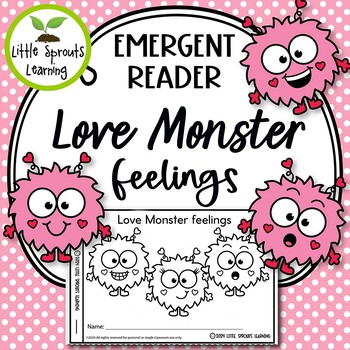The Love Monster And Self-Esteem

Table of Contents
The Love Monster as a Tool for Emotional Literacy
The Love Monster is more than just a fun story; it's a valuable tool for building emotional literacy in young children. The book beautifully illustrates a wide range of emotions, helping children identify and understand their feelings—from happiness and excitement to sadness, anger, and fear. This emotional vocabulary is essential for self-regulation and self-acceptance.
- Examples of emotions and their link to self-esteem: The Love Monster's journey highlights how accepting difficult emotions (like loneliness or frustration) doesn't diminish self-worth, but rather makes it stronger. The monster's initial fear of being different gradually transforms into self-acceptance and confidence as he learns to understand and manage his emotions.
- Normalizing a range of feelings: The Love Monster shows children that it’s okay to feel a multitude of emotions. There's no "right" or "wrong" way to feel. This normalization reduces the stigma around negative feelings, encouraging self-compassion and reducing the pressure to suppress emotions.
- Importance of emotional vocabulary: The story implicitly teaches children the language of emotions, empowering them to articulate their feelings to themselves and others. This clear understanding of emotions is a cornerstone of self-regulation and self-acceptance. A child who can name their emotions can better understand and manage them.
Building Self-Esteem Through Empathy and Compassion (as shown in The Love Monster)
The Love Monster profoundly emphasizes the importance of empathy and compassion – both for oneself and others. The monster’s journey of self-discovery is intertwined with his interactions with other creatures, teaching him the power of kindness and understanding.
- Examples of empathy and compassion: The Love Monster learns to understand and respond to the needs of others, showing compassion and care. He helps his friends, leading to a reciprocal feeling of belonging and acceptance, vital elements in cultivating self-esteem.
- Positive self-image and self-worth: By acting with empathy and compassion, the monster cultivates a positive self-image. His actions demonstrate that contributing positively to others enhances his own sense of self-worth and belonging.
- Connecting empathy with self-esteem: Understanding the feelings of others fosters self-understanding. By acknowledging and validating the emotions of those around him, the Love Monster learns to better understand and validate his own emotional experiences.
The Love Monster and the Power of Self-Acceptance
The Love Monster beautifully illustrates the journey towards self-acceptance, embracing imperfections and vulnerabilities. The monster's initial fear of being different transforms into embracing his unique qualities.
- Embodiment of self-acceptance: The Love Monster's transformation demonstrates that it's okay to be different. He learns to accept his unusual appearance and emotional complexities, eventually finding self-acceptance.
- Positive self-talk and self-encouragement: The story implicitly encourages positive self-talk and self-encouragement. The Love Monster's journey showcases the power of positive self-perception in overcoming challenges and building self-esteem.
- Activities promoting self-acceptance: Parents and educators can utilize the story to create activities that promote self-acceptance in children. For instance, creating self-portraits and discussing personal qualities, both positive and challenging, can help children embrace their individuality.
Practical Activities Inspired by The Love Monster to Boost Self-Esteem
Inspired by The Love Monster's themes, several practical activities can help parents and educators foster self-esteem in children:
- Creative writing prompts: Encourage children to write stories about their own feelings, using the characters and themes from The Love Monster as inspiration. For example, "Write a story about a time you felt scared, and how you overcame your fear."
- Role-playing scenarios: Create role-playing scenarios where children practice empathy and compassion. For example, "Imagine you are the Love Monster; how would you help a friend who is feeling sad?"
- Art projects: Engage children in art projects that allow them to express their emotions and explore their self-discovery journey. Creating self-portraits that reflect their inner feelings can be a powerful exercise.
Cultivating Self-Esteem with The Love Monster and Beyond
The Love Monster provides a powerful and engaging approach to building self-esteem in children. By fostering emotional literacy, empathy, self-acceptance, and self-compassion, this beloved character helps children develop a strong sense of self-worth. Remember the importance of emotional intelligence, self-love, and positive self-perception in a child's development.
Use The Love Monster as a springboard to cultivate strong self-esteem in your child today! Discover how The Love Monster can help your child embrace self-love and build unshakeable self-esteem. Through engaging storytelling and practical activities, you can empower your child to navigate the emotional landscape with confidence and self-acceptance.

Featured Posts
-
 D Wave Quantum Qbts A Top Quantum Computing Stock In 2024
May 21, 2025
D Wave Quantum Qbts A Top Quantum Computing Stock In 2024
May 21, 2025 -
 Robert Burke Bribery Conviction Four Star Admiral Found Guilty
May 21, 2025
Robert Burke Bribery Conviction Four Star Admiral Found Guilty
May 21, 2025 -
 Wtt Star Contender Chennai India Fields Record 19 Table Tennis Players
May 21, 2025
Wtt Star Contender Chennai India Fields Record 19 Table Tennis Players
May 21, 2025 -
 Novelistes L Espace Julien Avant Le Hellfest
May 21, 2025
Novelistes L Espace Julien Avant Le Hellfest
May 21, 2025 -
 Antiques Roadshow Leads To Jail Time For Couple With Stolen Items
May 21, 2025
Antiques Roadshow Leads To Jail Time For Couple With Stolen Items
May 21, 2025
Latest Posts
-
 Is This Ai Quantum Computing Stock A Buy On The Dip One Key Factor
May 21, 2025
Is This Ai Quantum Computing Stock A Buy On The Dip One Key Factor
May 21, 2025 -
 One Strong Reason To Consider This Ai Quantum Computing Stock
May 21, 2025
One Strong Reason To Consider This Ai Quantum Computing Stock
May 21, 2025 -
 Ai Quantum Computing Stock One Compelling Reason To Invest Now
May 21, 2025
Ai Quantum Computing Stock One Compelling Reason To Invest Now
May 21, 2025 -
 D Wave Quantum Qbts Stock Thursdays Drop And Its Implications
May 21, 2025
D Wave Quantum Qbts Stock Thursdays Drop And Its Implications
May 21, 2025 -
 1 Reason To Buy This Ai Quantum Computing Stock During A Market Dip
May 21, 2025
1 Reason To Buy This Ai Quantum Computing Stock During A Market Dip
May 21, 2025
